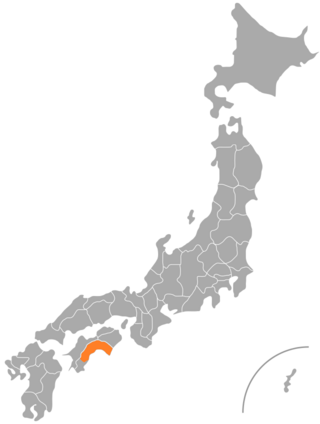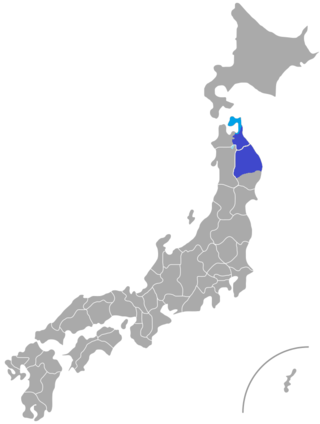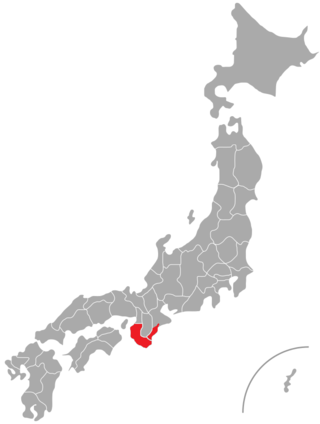
The Miyakoan language is a diverse dialect cluster spoken in the Miyako Islands, located southwest of Okinawa. The combined population of the islands is about 52,000. Miyakoan is a Southern Ryukyuan language, most closely related to Yaeyama. The number of competent native speakers is not known; as a consequence of Japanese language policy which refers to the language as the Miyako dialect, reflected in the education system, people below the age of 60 tend to not use the language except in songs and rituals, and the younger generation mostly uses Japanese as their first language. Miyakoan is notable among the Japonic languages in that it allows non-nasal syllable-final consonants, something not found in most Japonic languages.
The kitsune no yomeiri is a term or metaphor for certain natural phenomena, or a folk belief regarding a supernatural event, in Honshu, Shikoku, and Kyushu. The term "kitsune no yomeiri" can refer to several things: atmospheric ghost lights, in which it appears as if paper lanterns from a wedding procession are floating through the dark; sunshowers; or various other phenomena that may resemble wedding processions and are referenced in classical Japanese kaidan, essays, and legends. The kitsune no yomeiri is always closely related to foxes, or kitsune, who often play tricks on humans in Japanese legend; various Shinto rituals and festive rites relating to the kitsune no yomeiri have been developed in various parts of Japan.

The Tosa dialect is a Japanese Shikoku dialect spoken in central and eastern Kochi Prefecture, including Kochi City. The dialect of the Western region of Kochi Prefecture is called the Hata dialect and is drastically different from the Central and Eastern dialect.

The Ibaraki dialect is a Japanese dialect spoken in Ibaraki Prefecture. It is noted for its distinctive use of the sentence-ending particles べ (be) and っぺ (ppe) and an atypical intonation pattern that rises in neutral statements and falls in questions. It is also noted for its merging of certain vowels, frequent consonant voicing, and a relatively fast rate of speech.

The Satsugū dialect, often referred to as the Kagoshima dialect, is a group of dialects or dialect continuum of the Japanese language spoken mainly within the area of the former Ōsumi and Satsuma provinces now incorporated into the southwestern prefecture of Kagoshima. It may also be collectively referred to as the Satsuma dialect, owing to both the prominence of the Satsuma Province and the region of the Satsuma Domain which spanned the former Japanese provinces of Satsuma, Ōsumi and the southwestern part of Hyūga. The Satsugū dialect is commonly cited for its mutual unintelligibility to even its neighboring Kyūshū variants, prompting the Max Planck Institute for Evolutionary Anthropology to classify it as a distinct language in the Japanesic branch in its Glottolog database. It shares over three-quarters of the Standard Japanese vocabulary corpus and some areal features of Kyūshū.
Atmospheric ghost lights are lights that appear in the atmosphere without an obvious cause. Examples include the onibi, hitodama and will-o'-wisp. They are often seen in humid climates.

The Banshū dialect, also called the Harima dialect, is a Japanese dialect spoken in the Harima region of southwestern Hyōgo Prefecture. Although it is included in the Kansai dialect group, it shares much of its vocabulary with Chūgoku group. It can be further subdivided into the Western Banshū dialect and the Eastern Banshū dialect.

The Gunma dialect is a Japanese dialect spoken in Gunma Prefecture.

The Shizuoka dialect is a Japanese dialect spoken in Shizuoka Prefecture. In a narrow sense, this can refer purely to the Central Shizuoka dialect, whilst a broader definition encompasses all Shizuoka dialects. This article will focus on all dialects found in the prefecture.

The Kaga dialect is a Japanese Hokuriku dialect spoken south of Kahoku in the Kaga region of Ishikawa Prefecture.

The Bingo dialect is a Japanese dialect spoken in the Bingo Region of eastern Hiroshima Prefecture. It is part of the Chūgoku dialect group.

The Inshū dialect is a Japanese dialect spoken in the Inaba region of eastern Tottori Prefecture. It may also be called the Tottori dialect, though this is not to be confused with other dialects that are also spoken in the prefecture, namely the Kurayoshi and West Hōki dialects. It is considered an East San’in dialect of the wider Chūgoku dialect group. In parts of northern Hyōgo Prefecture that neighbour Tottori, specifically in the Tajima region, a similar dialect to the Inshu dialect is spoken. It bears many similarities to its close relative, the Kurayoshi dialect of central Tottori but retains some notable differences.

The Nanbudialect is a Japanese dialect spoken in an area corresponding to the former domains of Morioka and Hachinohe in northern Tohoku, governed by the Nanbu clan during the Edo period. It is classified as a Northern Tohoku dialect of the wider Tohoku dialect group.

The Narada dialect was a Japanese dialect spoken in the village of Narada, Hayakawa, located in Yamanashi Prefecture. Having formerly been isolated for centuries from surrounding areas, the dialect was considered a language island within the Tokai-Tosan dialect group, possessing various traits unique to Narada.

The Nairiku dialect is a Japanese dialect spoken in the eastern half of Yamagata Prefecture. It belongs to the Southern Tohoku dialect group.

The Northern Izu Archipelagodialects are dialects of Japanese spoken on the inhabited islands north of Mikura-jima in the Izu Archipelago, part of the Tokyo Metropolitan Area. The various dialects are classified as Eastern Japanese, and are most similar to the Izu dialect of mainland Honshū, but as islands have also developed unique traits which can vary considerably from island to island. On islands with large numbers of migrants from the mainland, such as To-shima, there is increasing standardisation of speech towards the common standard.

The Chikuzen dialect is a Japanese dialect spoken in western Fukuoka Prefecture in an area corresponding to the former Chikuzen Province. It is classified as a Hichiku dialect of the wider Kyushu dialect of Japanese, although the eastern part of the accepted dialect area has more similarities with the Buzen dialect, and the Asakura District in the south bears a stronger resemblance to the Chikugo dialect. The Chikuzen dialect is considered the wider dialect to which the Hakata dialect, the Fukuoka dialect and the Munakata dialect belong.

The Nagasaki dialect is the name given to the dialect of Japanese spoken on the mainland part of Nagasaki Prefecture on the island of Kyushu. It is a major dialect of the wider Hichiku group of Kyushu Japanese, with similarities to the Chikuzen and Kumamoto dialects, among others. It is one of the better known Hichiku dialects within Japan, with various historical proverbs that relate to its regional flavour.

The Kishū dialect is a Kansai dialect of Japanese spoken in the former province of Kino, in what is now Wakayama Prefecture and southern Mie Prefecture. In Wakayama Prefecture the dialect may also be referred to as the Wakayama dialect.

The Okuyoshino dialect is a Kansai dialect of Japanese spoken in several villages in the Okuyoshino region of southern Nara Prefecture. It is well-known as a language island, with various rare and unique characteristics.


















